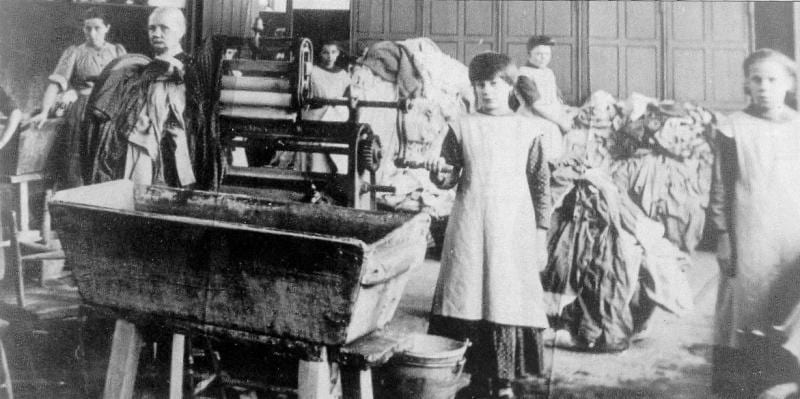Justice for Magdalens
By Gemma Angel, on 12 November 2012
 by Lisa Plotkin
by Lisa Plotkin
Many visitors to the Grant Museum of Zoology reacted very strongly to the recent exhibit Buried on Campus, which ran from April 23rd until July 13th. In fact, almost every single conversation I struck up with visitors during my time on the museum floor had something to do with the story the exhibit was telling – namely, the discovery of the remains of 180 individuals were discovered buried underneath the main quad at UCL in 2010. Visitors were surprised, inquisitive, and incredulous. Where did the bones come from? they wanted to know. When were they buried? Was UCL aware of this all along? Conspiracy theories abounded.
And it was not just the visitors who were asking questions. My fellow engagers did as well, with both Katie and Sarah writing blog posts on the topic. It seemed everyone was interested in reclaiming these human remains and reinserting them into an historical narrative. Buried on Campus also touched on a topic that is prominent in my own doctoral research, recalling the same questions that Sarah, Katie, and visitors alike asked: mainly, where in history do these bones belong and what are we going to do with them now?
From the main quad of UCL I will detour to Dublin, where in 1993 an order of nuns put up a portion of their estate for sale to a real estate developer. Subsequently, the remains of 155 women were found buried in unmarked graves on the grounds. Their discovery was a catalyst for which revealed the hidden history of the Magdalen Asylums – or the Magdalen Laundries, as they were also known. If you haven’t already heard of Magdalen Asylums then perhaps you can guess their purpose from their namesake. These asylums were built to serve as penitentiaries for the housing and redemption of ‘fallen’ women. Their target demographic was prostitutes, but other so-called ‘deviant’ women were also admitted, for crimes ranging from unmarried motherhood to mental instability. While Magdalen Asylums were first created in the late 18th century, it wasn’t until post-famine Ireland that they were transformed from voluntary refuges for cast-out women to punitive institutions, which sometimes detained their inmates unwillingly for life.
Magdalen Asylums were supposed to offer a new vision for post-famine Irish society. They would solve the problems of poverty, family breakdown, and moral decline. As the Reverend Father Kerr explained:
The appalling demoralization of our times is evidenced mostly in the decline of that virtue amongst woman-kind which is her chief glory and title to our esteem. To-day in ever increasing numbers “Magdalen” has imitators in her sin. But few will share her penance.[1]
But that was no longer true due to these Asylums; now fallen women could share her penance. And repent they did. The women penitents were required to work long hours in laundries for no pay. They were to live under a regime of prayer, silence, and complete obedience and they were separated from their children. They could no longer leave voluntarily, as the late 19th century ushered in a preference for permanent inmates.
This 1897 account sums up the situation succinctly:
At five o’clock I was at the Magdalen Home and was introduced by the Mother Superior of the Convent of Mercy to the Sister-in-Charge and six nuns who managed the laundry. We were all seated in the Sisters’ parlour where I put my questions. Most were answered by the Sister-in-charge.
“How many girls have you?”
“Seventy-three”
“How many are unmarried mothers?”
“About 70 percent”
“And the others?”
“Some are sent here when they leave the Industrial School because they need special
care.”
“Are they mental defects”?
“No.”
“Backward”?
“Yes.”
“Are the girls paid?”
“No, they earn their keep.”
…
“Are the girls free?”
“Yes.”
“Can a girl leave whenever she chooses?”
MOTHER SUPERIOR: “No, we’re not as lenient as all that. The girl must have a suitable
place to go…”
“How long do they stay”?
“Some stay for life” [2]
These asylums continued to operate up until the 1980s. In 1997 the documentary Sex in a Cold Climate premiered, featuring the testimonials of four former penitents. The women spoke of having to endure physical and sexual abuse while incarcerated against their will and one woman spoke of being forcibly separated from her child. Since then there have been numerous documentaries chronicling the physical and psychological abuse that the estimated 30,000 Magdalens suffered. Calls for justice for these forgotten women resound in Ireland today, and on June 6th, 2011 the United Nations Committee Against Torture put out a statement urging the Irish government to investigate the claim that thousands of girls and women were tortured in Catholic laundries.
As I reflect on the impact that Buried on Campus had on the UCL community, I can only imagine the impact that the 1993 discovery must have had in Ireland. Visitors to the Grant wondered at our complicity in the deaths of those 180 people buried underneath our lecture halls, and many were adamant that the narratives of these unknown people should be reasserted into UCL’s history. I am happy to say that over the past two decades Irish historians, and the Irish public, have given us a great model to follow in doing just that. And whilst justice was not granted to the unknown 155 buried in a mass grave within a convent’s walls, their story is being told and their memory is not forgotten.
 Close
Close


